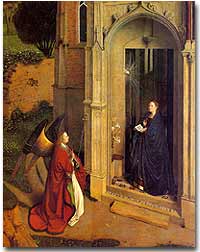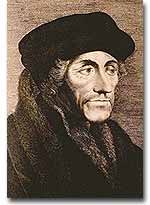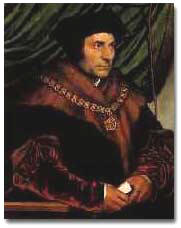| HOME |
The Northern Renaissance
The new learning and artistry of the Italian Renaissance could not be contained in Italy for long. The new ideas spread quickly, for Italian Renaissance culture was the envy of all of her neighbors. However, the Renaissance in the north would not be the same. The humanists of the Northern Renaissance placed a greater emphasis on Christianity, education, and reform. They sought to combine the best of the Ancient Greek and Roman world with the best that Christianity had to offer. The most famous of the Northern or Christian humanists was Desidarius Erasmus (1466-1536) of Rotterdam. Erasmus had an interest in education and religious reform. He believed that people should study the ancient classics and the Bible in an effort to reform themselves and society.
To aid in this effort, Erasmus translated the Bible into Greek. In addition, Erasmus worried about the increasing emphasis on ritual, ceremony, and rules in the Catholic faith. To counter this trend, he developed what he called, "the philosophy of Christ." This philosophy encouraged believers to examine Christ's life and words for examples of love and ethical behavior. In his most famous work, The Praise of Folly, Erasmus satirically examined all aspects of society, including the Church. Meanwhile, Thomas More (1478-1535), a close friend of Erasmus, was helping to introduce humanism in England. In his widely read Utopia, More presented a unique view of society. More's Utopia was an imaginary island near where Columbus had recently encountered the New World. Utopia described an idealistic society based on reason. The population was educated, worked hard, and shared the fruits of their labor. Since material wealth was divided equally, greed did not exist, and people did not desire material things. Therefore, in More's world the toilets could be made of gold. More believed that it was society's institutions that corrupted people. If you could create better societal institutions, you could create a better society. Ironically, the title of More's perfect society, Utopia, literally means "nowhere."
More is the first of many western thinkers to suggest the concept of a perfectly equal society. Ultimately, More's idealism would bring about his own death. King Henry VIII of England had Thomas More beheaded for opposing Henry's religious policies. More refused to compromise his beliefs to the end. In the realm of the arts, Italian Renaissance techniques spread across Europe. Local artists absorbed the new methods and used them in combination with their own methods. A German artist, Albrecht Durer (1471-1528), experimented with carved, intricate woodcuts and multiple vanishing-point perspective. Works such as The Four Horsemen of the Apocalypse incorporated religious themes in astonishing detail. Other Northern Renaissance artists include: the Spanish painter, El Greco and the Flemish painters, Jan van Eyck and Jerome Bosch. |
|||||||
| MAIN | ||||||||
| WEBQUEST CENTRAL | ||||||||
|


